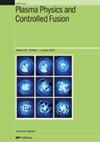将反向两点模型应用于 DIII-D 分流条件 *
IF 2.3
2区 物理与天体物理
Q2 PHYSICS, FLUIDS & PLASMAS
引用次数: 0
摘要
被称为 "反向两点模型"(Rev2PM)的扩展两点模型的预测形式被应用于DIII-D开放式下岔道中的一系列脱离水平,结果表明,如果且仅如果模型中包含对流热通量的后验修正,岔道入口处的实验测量电子温度(Te)和压力(pe)的计算结果与目标测量值的误差不超过50%。与标准 2 点模型不同,Rev2PM 根据目标条件(如 Te 和平行热通量)计算上游刮除层 (SOL) 的数量(如分离矩阵 Te 和 pe),而体积功率和动量损失仅取决于目标 Te。Rev2PM 是根据 DIII-D 分光镜间汤姆逊散射测量数据库进行测试的,该数据库由一系列 6 MW、1.3 MA、LSN H 模式放电建立,主离子密度、漂移方向和氮气膨化率各不相同。在该数据库中测量到的目标 Te 范围为 0.4-25 eV,上游 Te 范围为 5-60 eV。上游测量结果与假定纯传导平行热传输的 Rev2PM 计算结果之间的一致性很差。然而,引入后验修正以考虑对流热传输,使 Rev2PM 计算结果与整个数据集的上游测量值相差不超过 50%。这些修正意味着,在 DIII-D 开放式下部分流器的分离条件下,高达 99% 的平行热通量是由对流带走的,尽管还需要进一步的工作来评估与设备尺寸或分流器关闭的任何潜在相关性。本文章由计算机程序翻译,如有差异,请以英文原文为准。
Reversed-direction 2-point modelling applied to divertor conditions in DIII-D *
A predictive form of the extended 2-point model known as the ‘reverse 2-point model’, Rev2PM, is applied to a range of detachment levels in the open lower divertor of DIII-D, showing that the experimentally measured electron temperature (Te
) and pressure (pe
) at the divertor entrance can be calculated within 50% from target measurements, if and only if a posteriori corrections for convective heat flux are included in the model. Unlike the standard 2-point model, the Rev2PM calculates upstream scrape-off layer (SOL) quantities (such as separatrix Te
and pe
) from target conditions (such as Te
and parallel heat flux), with volumetric power and momentum losses depending solely on target Te
. The Rev2PM is tested against a database of DIII-D inter-ELM divertor Thomson scattering measurements, built from a series of 6 MW, 1.3 MA, LSN H-mode discharges with varied main ion density, drift direction, and nitrogen puffing rate. Measured target Te
ranged from 0.4–25 eV over this database, and upstream Te
ranged from 5–60 eV. Poor agreement is found between upstream measurements and Rev2PM calculations that assume purely conductive parallel heat transport. However, introducing a posteriori corrections to account for convective heat transport brings the Rev2PM calculations within 50% of the measured upstream values across the dataset. These corrections imply that up to 99% of the parallel heat flux is carried by convection in detached conditions in the DIII-D open lower divertor, though further work is required to assess any potential dependencies on device size or divertor closure.
求助全文
通过发布文献求助,成功后即可免费获取论文全文。
去求助
来源期刊

Plasma Physics and Controlled Fusion
物理-物理:核物理
CiteScore
4.50
自引率
13.60%
发文量
224
审稿时长
4.5 months
期刊介绍:
Plasma Physics and Controlled Fusion covers all aspects of the physics of hot, highly ionised plasmas. This includes results of current experimental and theoretical research on all aspects of the physics of high-temperature plasmas and of controlled nuclear fusion, including the basic phenomena in highly-ionised gases in the laboratory, in the ionosphere and in space, in magnetic-confinement and inertial-confinement fusion as well as related diagnostic methods.
Papers with a technological emphasis, for example in such topics as plasma control, fusion technology and diagnostics, are welcomed when the plasma physics is an integral part of the paper or when the technology is unique to plasma applications or new to the field of plasma physics. Papers on dusty plasma physics are welcome when there is a clear relevance to fusion.
 求助内容:
求助内容: 应助结果提醒方式:
应助结果提醒方式:


